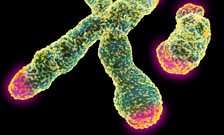(Medical Xpress)—Researchers at King's have revealed the genetic basis of high-arched palate in the mouth for the first time, a discovery that could pave the way for new treatments to reverse the condition.
Published this week in Developmental Cell, an early study has shown that a particular gene in mice triggers an overproduction of neural crest cells (which generate a variety of important cell and tissue types in the body) whilst in the embryo, causing the roof of the mouth to be compressed into an arch shape. The development of high-arched palate is therefore believed to occur much earlier than previously thought.
High-arched palate is associated with around 300 different conditions and can lead to a range of difficulties, including disrupted sleep caused by obstruction of the nasal passages, speech problems, and abnormalities in the head and neck. The condition is also associated with dental problems later in life, such as crowding of the molars.
Patients with ciliopathies frequently have high-arched palate. Ciliopathies are genetic disorders of cilia, the small hair-like structures on the surface of human cells. According to the authors a normal palate could be restored by decreasing the dose of the hyperactive Fgf8 gene, potentially removing the need for reconstructive surgery. The study also demonstrates the role of FGF gene hyperactivity in ciliopathies and links ciliopathies to craniosynostosis, a disorder which causes children to be born with, or develop, an abnormally shaped head.
Dr Karen Liu, from the Department of Craniofacial Development and Stem Cell Biology at King's College London's Dental Institute, who co-authored the report, said: 'The high-arched palate is a surprisingly common but little-studied component of human disease, receiving far less attention than cleft palates, for instance.
'High-arched palate poses challenges for feeding and speech, so the emergence of this genetic link could herald a potential target for new treatments aimed at reducing the activity of FGF genes to reverse the condition.'
Dr Liu added: 'Our research also reveals an important overlap between key genes and processes in ciliopathies, such as high-arched palate, and craniosynostosis. The latter affects an estimated one in every 1,800 to 3,000 children and occurs when the bones in the skull fuse too early in a child's life. When this happens, there is not enough room for the brain to grow and as a result, in severe cases, the child would need to undergo surgery to relieve the pressure on the brain. Our paper suggests that patients with ciliopathies such as high-arched palate may also be prone to these skull abnormalities.'
More information: www.cell.com/developmental-cel … /abstract/S1534-5807%2813%2900315-8
Journal information: Developmental Cell
Provided by King's College London


















